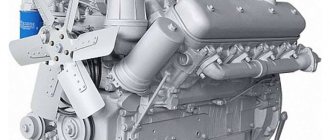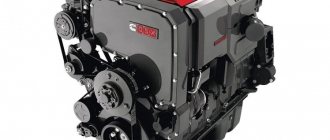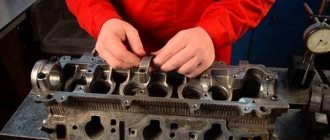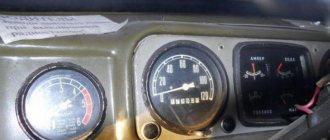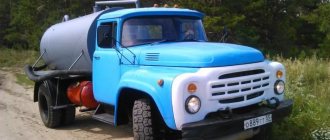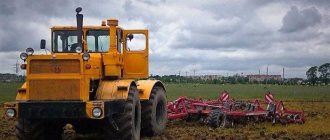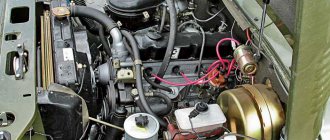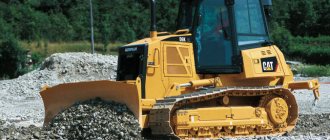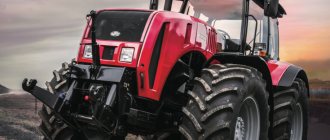Engine device
The motor is designed simply, which ensures reliability and ease of operation. The engine block is cast iron V-shaped with the cylinders spaced at an angle of 90⁰. The lower arrangement complements the unit and provides the necessary pickup capacity.
Depending on the modification, the engine is equipped with an atmospheric air supply system or turbocharging. Some versions have an independent head on each cylinder; initially there was one element on each side of the power plant.
YaMZ 238 operating diagram
The primitive design of the unit is entirely based on mechanics. The fuel pump pumps fuel into the cylinders where ignition occurs.
The crankshaft is directly connected to the distributor via a gear drive. From here the valves are activated, through pushers and rods - the standard operating sequence of a lower-jet diesel engine.
Operating principle of YaMZ 238
Completely similar to other diesel-type designs. YaMZ engines operate from the compression of diesel fuel in the combustion chamber. Mechanical fuel supply and air line drives are completely devoid of electronic components. This guarantees extraordinary stability in all conditions. The disadvantage of this design is high fuel consumption.
How much oil is in a YaMZ engine
Over the course of its existence, the YaMZ-238 engine has undergone many modifications, but the basic design has remained virtually unchanged.
This power unit is considered one of the most reliable and powerful for trucks and agricultural machinery. The volume of oil in the engine is the most important characteristic, failure to comply with which will prevent normal operation of the unit. This indicator is closely related to data such as the number of working hours before replacement and the class of lubricants recommended in the instructions.
History and characteristics of YaMZ 238
The Yaroslavl Motor Plant produces a whole line of engines, the prototype of which can be considered the YaMZ 238. Production of this engine began in 1962. It became an improved version of the previously assembled YaMZ 236 (six-cylinder), but for many years both power units continued to be actively used in parallel with each other. The family has many common features: design features, operating principles, similar technical indicators. Later, the YaMZ 530 appeared - four- and six-cylinder in-line engines, both diesel and gas.
The engines of the Yaroslavl plant serve on powerful MAZ, Urals, KrAZ trucks, tractors and combines, river and sea boats, as well as diesel power plants. Due to its reliability and unpretentiousness, the engine still remains in demand, and its production continues. The newest version of YaMZ-238/Euro-0 Turbo is distinguished by the presence of a turbine. In addition to other design improvements, it is equipped with a liquid-oil heat exchanger and a high-pressure fuel pump.
By design, the YaMZ-238 power unit is an eight-cylinder V-shaped double-row body made of low-alloy gray cast iron, the camber angle of this engine is 90°.
Main design features and technical characteristics:
- offset of the cylinder rows relative to each other by 35 mm;
- working volume 14.85 l;
- naturally aspirated;
- power from 180 to 240 hp;
- fuel consumption (100% power) – 227 g/kW hour.
Oils for YaMZ
The strength of the YaMZ 238 engine is a carefully thought-out and trouble-free oil lubrication system for all components. A mixed scheme is used here, its operating principle is that the main and connecting rod bearings located in the key components of the unit - the camshaft and crankshaft - are lubricated under pressure. Also serviced are the connecting rod upper head bushings, oil pump idler gear, valve rocker arm bushings, pushrod bushings and spherical rod bearings. The remaining elements - the cylinder bore, rolling bearings, gears and camshaft cams - do not require as much lubrication and are maintained by spraying. A system of oil channels is provided on the walls of the cylinder block to supply lubricant to the components and filters of the mechanism.
According to the instructions, GOST 5304-54 diesel oil is used to service 238 series engines. Also in the accompanying documents you can find recommendations for the use of motor oil additives that improve the functioning of the oil filled into the engine.
Main elements of the YaMZ 238 lubrication system:
- standard gear type oil pump;
- centrifugal fine oil filter with jet drive;
- Full-flow oil filter based on a metal mesh with a replaceable filter element.
Characteristics of YaMZ 238 filling containers
The YaMZ 238 engine uses a mixed-type lubrication system with a “wet” sump.
You can find out how much oil will need to be poured into the YaMZ 238 engine based on the size of the unit’s filling tanks. In particular, the lubrication system has a volume of 32 liters of oil.
The engine cooling system without a radiator requires 20 liters of lubricants. The fuel pump needs 0.2 liters, the air filter capacity is 1.4 liters. The 238 model, unlike the 236, does not have a regulator.
The oil volume in the YaMZ 238 engine is measured using a special dipstick with o and “minimum”. 24-28 liters are poured at a time, despite the fact that the working volume of the lubrication system of this power unit reaches 32 liters. if during operation the oil pressure in the system is increased to more than 520 kPa (5.2 kgf/sq.cm), excess lubricants are returned through the oil line and simultaneously cleaned by filters.
Maintenance and repair of YaMZ 238
It is recommended to carry out service maintenance of the YaMZ 238 engine after 20,000 - 25,000 km. When checking, the oil pressure should give readings of 4-7 kgf/cm2 on a warm engine. The indicator is the same for atmospheric and turbo systems. Changing lubricants is necessary during scheduled maintenance, as well as when drips, smoke, or knocking appear when the engine is running, while the capacity of different systems varies, as does the replacement time.
You can familiarize yourself with the technology for servicing power units in the repair and operation manual developed by the manufacturer. The set of mandatory operations when carrying out maintenance of an internal combustion engine at the Yaroslavl plant includes the following manipulations:
- Change of oil;
- checking and replacing filters: fine filter,
- coarse filter,
- fuel purification filters,
- eco-filter exhaust system,
- air filter;
Important : the YaMZ 238 engine urgently needs repairs if blue smoke appears during operation. This indicates that the lubricant is burning.
Technical characteristics of YaMZ 238
The engine parameters without a turbine are as follows.
| Index | Meaning |
| Working volume, l. | 15 |
| Fuel type | Diesel |
| Cylinder configuration | V-shaped |
| Number of cylinders | 8 |
| Number of valves | 16 |
| Compliance with environmental standards | EURO-0/4 |
| Cylinder diameter, mm. | 130 |
| Piston stroke, mm | 140 |
| Compression ratio | 17,5 |
| Cooling system | Liquid |
| Declared resource, km. | 1000000 |
| Cylinder operating order | 1-5-4-2-6-3-7-8 |
| Power, hp | Up to 420 |
| Total weight, kg | Before 1370 |
| Idle speed | 600 |
| Maximum speed | 2100 |
| Compression is normal, kg/cm | 33-38 |
Working temperature
The optimal temperature for the YaMZ 238 motor is in the range from 72 to 98 degrees Celsius. This develops maximum power and fuel combustion efficiency.
The exact heating rate depends on the type of equipment where the motor is installed.
Fuel consumption per hour YaMZ 238
Depending on the modification and type of equipment where the engine is mounted, the YaMZ 238 consumes from 21 to 35 liters per 100 km. Also in the model range there are variations with a consumption of about 40 l/100 km.
Conclusion
The YaMZ 238 engine is considered a legend of the domestic automotive industry. For more than half a century of production, the power unit has proven itself to be reliable and easy to repair. For these qualities, he was loved by motorists.
It is worth noting that YaMZs, both 238 and 236, were often exported in large quantities. For example, China orders engines of this series for its heavy-duty trucks, since only BELAZ and Caterpillar can compete with YaMZ, but they are much more expensive than their domestic counterpart.
Maintenance
According to the manufacturer's regulations, the engine must be serviced every 20-25 thousand km.
The quality of domestic fuel and difficult operating conditions impose their own limitations. Experienced users advise servicing the internal combustion engine after 15,000 km. At this time, procedures are performed.
- Changing oil and filters.
- Adjusting the valve mechanism.
- Inspection of the fuel supply system.
- Servicing diesel injectors.
Engine repair: basic description
Repairing the YaMZ 238 engine is a whole range of operations to restore the performance of the engine, which is not recommended to be done with your own hands. So, it’s worth turning to professionals who can correctly diagnose faults and wear, as well as which internal element needs to be replaced. Let's consider the main set of operations that are carried out for the YaMZ 238 motor in order to carry out a major overhaul of the motor:
- Superficial diagnostics of faults is carried out by ear. The mechanic determines the presence of extraneous noise, as well as the preliminary location.
- Removing the engine from the car, as well as completely disassembling the power unit.
- Measurements of cylinders and crankshaft. Determining the repair number, as well as ordering spare parts. As practice shows, in most cases, in order not to bore the engine cylinders, the block is sleeved. This parameter allows, in case of subsequent repairs, to bore not the block, but the sleeves, which, when worn, can be removed and new ones inserted.
- Cylinder head repair.
- Assembly of the power unit.
A separate parameter is the restoration of the injection pump. As practice shows, the technician repairs only the plunger pair, which wears out most often.
As for on-line repair operations, every owner of a car with a YaMZ engine has sufficient skills and knowledge to restore their engine themselves, the main thing is that the hand grows from the right place. The most common problems include:
- Starter and generator malfunction.
- Failure of the water pump.
- Replacing drive belts.
- Adjusting the valve mechanism.
- Change of oil.
- Replacing engine filters.
Repair instructions for each unit are available on the Internet or you can use factory books that are publicly available.
Malfunctions YaMZ 238
With proper care and the use of original parts, the engine usually does not act up. The only complaint is the fuel supply system. When filling with low-grade diesel fuel, the fuel injection pump quickly wears out, which forces drivers to choose gas stations more carefully.
Turbo version Represents a modification of the aspirated engine with appropriate modifications.
Thanks to improved design, the motors develop a power of over 330 horses, which allows them to be mounted in heavily loaded equipment. The turbine engine also has better dynamics and responsiveness. The supercharger drive is mechanical, the lubrication system is the main module.
Fuel injection pump YaMZ-236
YaMZ-236 engines are equipped with multi-section high-pressure fuel pumps. The fuel injection pump has a gear drive. The pump itself is located in the camber of the cylinder block and is connected to the fuel line. Structurally, the injection pump consists of the following components:
- Plunger pairs that perform the functions of valves, ensuring the tightness of the structure. To ensure the required level of tightness and maintain pressure, the surfaces of the plungers are ground on special machines. If you deviate from the norms during grinding, tightness is lost, pressure drops, fuel consumption increases and, in general, the efficiency of the diesel engine decreases.
- Booster pump (pump) , which provides fuel pumping to the injection pump itself in case of long engine downtime. This second pump complements the main one.
- Cam shaft , which drives the entire structure. The pushers on the shaft press on the valves and fuel is pumped.
Diagram of the high pressure fuel pump of the YaMZ-236 engine:
1-fuel pump housing; 2-stop; 3-rail; 4-tooth ring; 5-bypass valve; 6-plunger; 7-fitting; 8-cork; 9-regulator housing; 10-thrust; 11-tooth regulator drive wheel; 12-cam shaft; 13-flange; 14-eccentric; 15-roller; 16-turn bushing; 17-protrusions of the plunger; 18-pusher; 19-cam; 20-ball bearing; 21-support finger; 22-clutch spring; 23-drive half-coupling; 24-coupling cover; 25 weight; 26-driven coupling half; 27-axis weight; 28 and 39 spring support plates; 29-stop bushing screw; 30-channel fuel outlet; 31-discharge valve spring stop; 32-discharge valve spring; 33-discharge valve; 34-discharge valve seat; 35-plunger bushing; 36-channel fuel supply; 37-lock rack screw; 38-plunger spring; 40-adjustment bolt.
The injection pump of the YaMZ-236 engine has an autonomous lubrication system, i.e. it does not depend on the lubrication of the motor itself. To purify the oil there is a double filtration system - coarse and fine. The oil level can be monitored using a wire dipstick with marks.
Adjusting the injection pump
The injection pump is adjusted in order to change the amount of fuel supplied to the system. Fuel supply is determined based on the current engine load. Adjustment can help maintain the required crankshaft speed.
For simple, manual adjustment, there is a special wrench bolt on the side of the pump body. By rotating it, you can adjust the idle speed, changing the fuel supply, as well as completely shutting it off.
For finer adjustment of the YaMZ 236 injection pump, diesel fuel is first filled to the upper mark. Then, within 2 minutes, the valves are checked for tightness using the pressurized fuel pressure test method. During this period, leakage is unacceptable. The bypass valve is closed with a plug.
Next, the fuel supply corrector is checked. The fitting filter is washed in gasoline and blown with compressed air. The holes are cleaned with soft wire.
The next step is to check the tightness of the membrane. Air under pressure is supplied to the housing cover.
To adjust the cyclic fuel supply to the injection pump, there is a special control panel on the lever. By screwing it in, the fuel supply increases; by unscrewing it, it decreases accordingly. After adjustment, the bolt must be locked.
To regulate the fuel supply at an intermediate pressure value, a spring is used. Screwing it in reduces it, unscrewing it increases the fuel supply. Then the spring housing is also secured using a nut.
Next, the boost corrector is checked. The fuel injection pump stop lever is turned 45 degrees, and the fuel supply should stop.
The power reserve of the pump rack is also checked. If there is no play, the screw is turned out until it stops. The free play should be within 1-1.5 mm.
If self-adjustment does not bring results, then you will need a special stand and a well-trained person.
Gearbox YaMZ-236
Gearboxes for the YaMZ-236 family of diesel engines are five-speed, mechanical, three-way gearboxes with synchronizers in 2-3 and 4-5 gears. There are five gears for forward movement and one gear for reverse movement.
YaMZ-236 gearbox diagram:
1-clutch release; 2-primary shaft; 3 and 15 bearing caps; 4-clutch housing; 5 and 10 synchronizers; 7-ball retainer; 8 and 22 fifth gear gears; 9 and 21 third gear gears; 11 and 19 gears of the second gear; 12-gear first gear and reverse; 13-top cover; 14-secondary shaft; 16-flange; 17-intermediate shaft with first gear; 18-gearbox housing; 20-oil pump intake with magnet; 23-gear power take-off; 24-gear drive of the intermediate shaft; 25-oil pump; 26-axis reverse gear unit; 27-reverse gear block; 28-gear speedometer drive.
This is a fairly reliable box, which is confirmed by its installation on heavy-duty equipment operating in difficult conditions. Gearbox components and parts are made from high-quality materials. The good maintainability of the YaMZ-236 gearbox allows you to repair both its individual parts and replace entire units.
Modifications
Box modifications: YaMZ-236P, YaMZ-236PO, YaMZ-236N, YaMZ-236L, YaMZ-236U, YaMZ-236UO. They all have different purposes and depending on this, one or another gearbox is installed on the engine.
YaMZ 236P is considered the base model. There is a plug on the cover of the device, and on the cover of the output shaft there is a flange that ensures the operation of the speedometer and a driveshaft flange.
YaMZ 236P3 is manufactured for a diaphragm clutch. It is distinguished by the presence of a clutch release clutch and a bracket that engages the cylindrical spring of the clutch.
YaMZ 236P4 differs from P3 in the end splines on the driveshaft flange.
YaMZ 236P5 is a basic gearbox model, on which a short lever is installed on the cover instead of a plug. Cardan shaft with conventional flange.
YaMZ 236P7 is a P5 model for a diaphragm clutch. It differs from the base model in the dimensions of the clutch, which disengages the clutch mechanism, and in the presence of an engaging bracket.
The YaMZ-236U differs from the 236P in the presence of a gear shift lever and the absence of a flange for the speedometer drive mechanism on the output shaft cover.
YaMZ-236U3 is a 236U for a diaphragm clutch. It differs in the size of the clutch release clutch and the presence of a bracket for engaging the clutch release coil spring.
YaMZ-236U4 and 236U are hermetically sealed, distinguished by cast clutch starter hatch covers, a breather is installed on the top cover, and a plug on the bottom.
YaMZ-236U5 - 236U3 in a sealed design for a diaphragm clutch. It is distinguished by cast clutch starter hatch covers, a breather is installed on the top cover, and a plug on the bottom.
Gearbox Specifications
- Torque – 930 Nm.
- Weight – 240-250 kg.
- Switching – Lever/flange.
- Fastening the cardan shaft – Smooth flange for 8 bolts M10*155mm.
- Power take-off – Through the crankcase from a spur gear (up to 29.5 kW/40 hp) or from a gear coupling (up to 73.5 kW/100 hp) (additional option).
- Application: KrAZ, MAZ, ZIL, Ural vehicles, MoAZ scraper, MAZ, LAZ, LiAZ, MARZ, Neman, Volzhanin buses.
Gear ratios
| Broadcast | Gear ratio |
| 1 | 5,26 |
| 2 | 2,90 |
| 3 | 1,52 |
| 4 | 1,00 |
| 5 | 0,66 |
| Reverse | 5,48 |
Some features of the gearbox
- The gearbox lubrication system is mixed. Some components are lubricated under pressure, and others by splashing.
- The oil collector is equipped with a mesh with a magnet, which allows you to clean the oil from metal shavings and particles.
- The speedometer drive is located in the secondary shaft cover.
- The internal gearbox map communicates with atmospheric air through a breather.
- A protection system against simultaneous engagement of two gears has been introduced into the design of the YaMZ-236 gearbox.
- The spring fuse prevents you from accidentally engaging reverse gear, and it also makes it difficult to engage first gear.
- The gearbox mechanism is equipped with inertia-type synchronizers for shockless engagement of gears from 2 to 5.
- To ensure equal angular speeds of the carriage and gears, the YaMZ-236 gearbox has a friction pair consisting of a conical synchronizer ring located on the gear wheel.
Collection of articles and technical documentation
technical documentation » YaMZ engines
Date of publication: 13/03/2010
Category: YaMZ engines
These changes came into effect in April 2001. In order to unify the cylinder blocks of YaMZ-236M2 and YaMZ-238M2 engines with the cylinder blocks of YaMZ engines ensuring compliance with the environmental requirements of "EURO-2" and to improve operational quality. These
changes came into effect in April 2001. d.
In order to unify the cylinder blocks of YaMZ-236M2 and YaMZ-238M2 engines with the cylinder blocks of YaMZ engines ensuring compliance with environmental requirements of “EURO-2” and to improve the performance qualities of these models, the plant made a number of design changes:
1. The location in the cylinder block for installation of the injection pump drive has been changed. The threaded holes for fastening the injection pump are made with M10x1.25-6N thread instead of M8-6N and have changed their original position due to the shift of the injection pump by 43 mm. towards the flywheel housing. To ensure interchangeability with the fastening elements of the block of the “old” design (M8 bolts), it is necessary to install BP 8x10 screws into the cylinder block (included in the delivery set of blocks with fuel injection pump drive parts). In order to improve the lubrication conditions for the fuel injection pump drive bearings, additional oil supply channels were made in the block. Plug 316105-P acts as a technological plug, and threaded plug 316101-P acts as a throttle. "Old" design cylinder blocks are not produced. To install new design cylinder blocks on “old” engines, kits 236-1002005, 1002005-A and 238-1002005, 1002005-A were produced, including modified and new fuel injection pump drive parts and threaded screws:
236-1029240-B Cuff with spring 1 pc. 236-1029034 Thrust ring 1 pc. 236-1029123 Thrust flange 1 pc. 236-1029154-B Driven gear shaft 1 pc. 236-1029172 Bearing housing 1 pc. 316105-P Plug K1/8” 1 pc. 45 9348 6557 Bolt M10-6gx20 3 pcs. 316700-P Threaded insert BP 8x10 4 pcs. 236-1104308-Д٭ NVD tube 1 pc.
٭ only for 6-cylinder engine models.
2. To improve the reliability of the nozzle seal, the seal design has been changed. There is a hole in the cylinder head through which a high-pressure tube with a nut passes to the injector, and the tube is sealed with a seal placed in the flange and pressed by a pressure sleeve through a washer. The flange with gasket is attached to the block head with two nuts and spring washers. In the new version, a nozzle with a shortened fitting is installed. Due to the above design changes, the cylinder head, injector and high-pressure fuel pipes of the new design are not individually interchangeable with the same elements of the “old” design.
3. The design of the injection pump drive has been changed, a centering plate has been introduced to facilitate the assembly and adjustment process.
4. The change in the location of the injection pump caused a change in the routing of the high and low pressure fuel pipes.
The interchangeability of fuel pipes is impaired. Changes
Name
| Before the change | Supply of old parts for spare parts | After change | Interchangeability | |||
| Part no. | Qty | Part no. | Qty | |||
| Cylinder block | 236-1002012-B2 | 1 | No | 236-1002012-B | 1 | Violated |
| 236-1002005٭1 | 1 | Not broken | ||||
| 236-1002012-B3 | 1 | No | 236-1002012-B2 | 1 | Violated | |
| 236-1002005-А٭1 | 1 | Not broken | ||||
| 238-1002012-B2 | 1 | No | 238-1002012-B | 1 | Violated | |
| 238-1002005٭2 | 1 | Not broken | ||||
| 238-1002012-B3 | 1 | No | 238-1002012-B2 | 1 | Violated | |
| 238Н-1002005-А٭2 | 1 | Not broken | ||||
| 238N-1002012-B3 | 1 | No | 238N-1002012-G | 1 | Violated | |
| 238Н-1002005٭2 | 1 | Not broken | ||||
| 238N-1002012-B4 | 1 | No | 238N-1002012-G2 | 1 | Violated | |
| 238Н-1002005-А٭2 | 1 | Not broken | ||||
٭1 Cylinder block after modification with drive parts, screw for the “old” injection pump and high pressure fuel pipe of the 4th cylinder. ٭2 Cylinder block after modification with drive parts, screwed in under the “old” injection pump
| Group | 1003 | |||||
| Head | 236-1003013-E3 | 2 | Yes | 236-1003013-Zh | 2 | Violated |
| cylinders | 236-1003013-E4 | 2 | Yes | 236-1003013-Zh2 | 2 | Violated |
| 238-1003013-D3 | 2 | Yes | 238-1003013-ZH | 2 | Violated | |
| 238N-1003013-B3 | 2 | Yes | 238-1003013-ZH | 2 | Violated | |
| Group | 1029 | |||||
| Val Ved. gears | 236-1029154-B2 | 1 | Yes | 236-1029154-B | 1 | Violated |
| Sub. 6-205K | 46 1212 1626 | 1 | ||||
| Sub. 306A | 46 1213 4023 | 1 | ||||
| Base housing | 236-1029172 | 1 | ||||
| Resistant ring | 236-1029034 | 1 | ||||
| Thrust flange | 236-1308107 | 1 | Yes | 236-1029123 | 1 | Violated |
| Cuff | 236-1029240 | 1 | Yes | 236-1029240-B | 1 | Violated |
| Center plate | 236-1029265 | 1 | ||||
| Bolt M8-6gх20 | 201456-P29 | 3 | ||||
| Washer 8T | 252135-P2 | 3 | ||||
| Bolt M10-6gх20 | 45 9348 6557 | 3 | ||||
| Group | 1104 | |||||
| Injection pump tube | 236-1104308-B | 6:8 | Yes | 236-1104308-G | 6:8 | Violated |
| Outlet tube | 236-1104384 | 1 | Yes | 236-1104384-B | 1 | Violated |
| 236-1104384-B | 1 | Yes | 236-1104384-G | 1 | Violated | |
| Outlet tube | 236-1104422-B | 1 | Yes | 236-1104422-G | 1 | Violated |
| 238-1104422-B | 1 | Yes | 238-1104422-D | 1 | Violated | |
| Supply tube | 236-1104426 | 1 | Yes | 236-1104426-G | 1 | Violated |
| 236-1104426-B | 1 | Yes | 236-1104426-D | 1 | Violated | |
| Transition gasket. | 240-1104368 | 6:8 | ||||
| Washer | 7511.1104342 | 6:8 | ||||
| Sealant | 7511.1104344 | 6:8 | ||||
| Flange | 7511.1104345 | 6:8 | ||||
| Pressure sleeve | 7511.1104359 | 6:8 | ||||
| Group | 1111 | |||||
| Supply tube | 236N-1111558 | 1 | Yes | 236NM-1111558 | 1 | Violated |
| oils for corr. | 238B-1111558-V | 1 | Yes | 238BM-1111558 | 1 | Violated |
| Supply tube | 238P-1111430 | 1 | Yes | 840.1022826 | 1 | Violated |
| air to corr. | ||||||
| Bolt M8-6gх85 | 200276-P29 | 4 | ||||
| Bolt M10x1.25-6gx90 | 200463-P29 | 4 | Violated | |||
| Washer | 312356-P29 | 4 | Yes | 312515-P29 | 4 | Violated |
| Group | 1112 | |||||
| Nozzle | 26.1112010-03 | 6:8 | Yes | 26.1112010-10 | 6:8 | Violated |
| 261.1112010-03 | 6:8 | Yes | 261.1112010-10 | 6:8 | Violated |
Change implementation date:
March 2005
Applicability:
YaMZ-236M2, 238M2, 7601.10, 7511.10 of all modifications and configurations.
Description of the change:
In order to unify the cylinder blocks of automobile engines with combine engines, on the front flange under the timing gear cover, 4 M10 holes were changed to M14, also on the timing gear cover, the diameter of the corresponding holes was increased and the height of 2 bosses in the area of the water pump was changed.
| Before the change | After change |
| Cylinder block assembly | |
| 236-1002005-B | 236-1002005-B2 |
| 236-1002012-G2 | 236-1002012-G3 |
| 236DK-1002012-B2 | 236-1002012-G3 |
| 236N-1002012-D2 | 236-1002012-D3 |
| 236N-1002012-B5 | 236N-1002012-B6 |
| 236N-1002012-G2 | 236N-1002012-G3 |
| 236N-1002005-B | 236N-1002005-B2 |
| 236BE-1002012 | 236BE-1002012-A2 |
| 236BE-1002012-A | 236BE-1002012-A3 |
| 236BE2-1002012 | 236BE2-1002012-A2 |
| 236BE2-1002012-A | 236BE2-1002012-A3 |
| 236NE2-1002012-A2 | 236NE2-1002012-A4 |
| 236NE2-1002012-A3 | 236NE2-1002012-A5 |
| 7601-1002012-02 | 7601-1002012-04 |
| 7601-1002012-03 | 7601-1002012-05 |
| 238-1002012-G2 | 238-1002012-G3 |
| 238AK-1002012-B2 | |
| 238-1002012-B4 | 238-1002012-B5 |
| 238AK-1002012-B3 | |
| 238-1002005-B | 238-1002005-B2 |
| 238ND4-1002012-B2 | 238ND4-1002012-B4 |
| 238ND4-1002012-B3 | 238ND4-1002012-B5 |
| 238N-1002012-Zh2 | 238N-1002012-Zh3 |
| 238N-1002012-D4 | 238N-1002012-D5 |
| 238N-1002012-E2 | 238N-1002012-E3 |
| 238DK-1002012-B2 | |
| 238N-1002012-G4 | 238N-1002012-G5 |
| 238DK-1002012-B3 | |
| 238N-1002005-B | 238N-1002005-B2 |
| 7511.1002012-02 | 7511.1002012-04 |
| 7511.1002012-03 | 7511.1002012-05 |
| 7511.1002012-12 | 7511.1002012-14 |
| 7511.1002012-13 | 7511.1002012-15 |
| Timing gear cover (assembled) | |
| 236-1002261-A | 236-1002261-A2 |
| 236-1002261-B3 | 236-1002261-B4 |
| 236-1002261-B | 236-1002261-B2 |
| 236-1002261-G | 236-1002261-G2 |
| 238B-1002261-B2 | 238B-1002261-B3 |
| 238B-1002261-B2 | 238B-1002261-B3 |
To ensure interchangeability when supplied as spare parts, an additional 4 screws (316633-P29) are attached to the cylinder block, and 2 bolts (45 9327 1074) M10-6gx105 and 4 flat washers (312300-P2) are attached to the timing gear cover.
To ensure interchangeability when supplied as spare parts, an additional 4 screws (316633-P29) are attached to the cylinder block, and 2 bolts (45 9327 1074) M10-6gx105 and 4 flat washers (312300-P2) are attached to the timing gear cover.
Before change: Installing the timing gear cover
After the change: Installing the timing gear cover
Key words: YaMZ cylinder block
